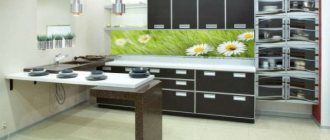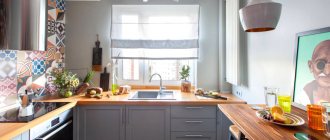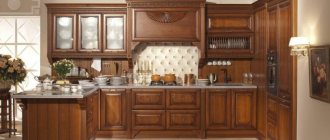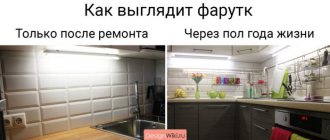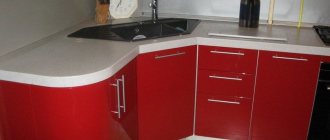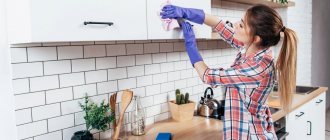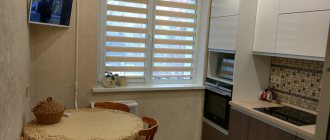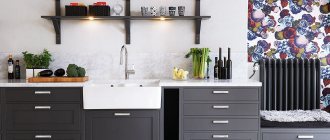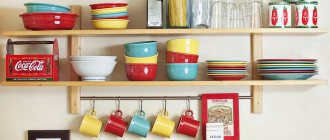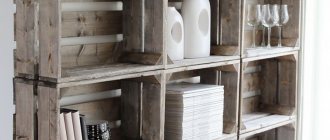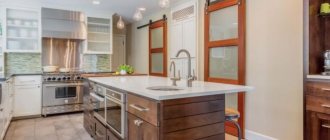How to coat and treat chipboard from moisture
The low cost of chipboard, high performance characteristics, and versatility of use have made them a very popular material.
The most common areas of application are furniture production and construction. The main enemy of these slabs is water - the chips increase in volume, the slab swells, warps and crumbles.[contents] Even at the very beginning of production, sawdust and shavings are impregnated with formaldehyde resins after drying. After pressing, the surface of the boards is laminated, sometimes even varnished.
But protecting the surface does not prevent the penetration of moisture from the ends through which it enters. Accumulating inside, water gradually begins to penetrate the wood fibers, which leads to the destruction of the slab. Consequently, the ends must first be saved from liquid penetration during operation. If they are tightly sealed, the service life of the slabs will be much longer.
The photo shows the effects of water on a chipboard countertop.
Why are the ends the starting point for destruction? Yes, because the production of slabs of the required standard sizes, as well as the preparation of pieces of material of different sizes, requires cutting. In this case, the integrity of the wood fibers is compromised.
Thus, chipboard protection from moisture is carried out in three directions:
- impregnation of wood fibers with resins;
- special surface treatment;
- end sealing.
Pros and cons of kitchen countertops made of chipboard
The kitchen work surface undergoes serious testing every day. It must be strong, safe and hygienic. Laminated particle board countertops have many benefits. However, it was not without its drawbacks.
Advantages of the material:
- Reliability . Chipboard is much better than wood at maintaining its appearance in tough kitchen tests.
- Easy to care for . Chipboard is impregnated with various resins, so it does not require excessive maintenance.
- Price . This is a cheap option for a countertop that has a long service life.
- Appearance. It has a wide range of colors and a variety of textures.
- The tabletop can be given any shape and length.
Reference . Despite the fact that the coating does not require special care, you should not use hard metal brushes for cleaning. They can damage the top laminated layer.
Flaws:
- Release of formaldehyde resins after heating.
- In places where there are frequent temperature changes, cracks may form over time.
- If the surface has chips or scratches, moisture entering through them causes the coating to swell.
- In appearance, this material is inferior to stone and wood; it does not look as elegant and expensive.
- Susceptibility to acids and alkalis.
Surface treatment of plates
The front and back surfaces of the slab, as the largest contact areas, without any protection, can pass through and absorb, accordingly, the largest amount of liquid. It would be a good idea to cover these surfaces with something moisture-proof. Some of the methods of such coating are possible only in factory conditions, some are also possible at home.
One of the main methods of protection is lamination. In this case, a melamine film is laid on sanded chipboard at high pressure and high temperature. The essence of this process is not pressing, but the fact that under these conditions the film polymerizes the surface of the slab, becoming one with it.
There is another method that is performed in the factory - laminating. Pressure and heat are also used here, but more gentle. The already hardened film is pressed against the glue-coated slab. If lamination is a chemical process, then laminating is a mechanical process.
Components of laminated chipboard
At home, non-laminated chipboard is often coated with several layers of paint for protection. Before painting, pre-treat the surface:
- dust is carefully swept away and washed off the surface;
- for the first time, the plate is coated with hot drying oil;
- then this is done with cold drying oil until an outer crust forms;
- the top is painted. With any painting method, you must remember that each subsequent layer of paint is applied to the already dried previous one.
There are several other ways to protect yourself from getting wet. For example, a surface that will not be subject to mechanical stress can be protected as follows: rub it with stearin, then heat it with a hairdryer. Let cool and repeat this a couple more times. Or: one part of bitumen varnish is mixed with five parts of drying oil. Coating is carried out twice.
How to paint a countertop
Laminated chipboard is one of the most popular materials for making kitchen furniture, including countertops.
Among the advantages in comparison with other materials, it is necessary to highlight strength, maintainability, and long service life. But any furniture sooner or later loses its original appearance. Then all that remains is to either change it or repaint it. If you buy a new headset, you will have to dismantle the existing one and solve problems with removal and disposal. Additional investments and time will be required to visit furniture showrooms or workshops.
The second option does not require any special costs or experience. The main thing is compliance with the technology and preliminary preparation of the necessary materials and equipment. With a little effort, the result will be a unique tabletop. In addition, you can update the color regularly, taking into account your mood, the weather outside or seasonality.
Next, we will consider step by step how and with what to paint the tabletop. All steps are required. It is not recommended to skip them in order to get a perfectly smooth and even surface.
Processing joints and edges
Water always looks for the lowest place, the depression. And what, if not a recess, are joints on horizontal planes? There are especially many such joints in cabinet furniture, which is made from chipboard. Kitchen furniture in general is like on the front line: there is plenty of water and enough evaporation. The most susceptible to moisture are the sink, cabinet with dryer, countertop, and furniture near and above the stove.
The taps all start to leak at some point. So, the most potentially dangerous place in the sink is where the faucet crashes into the countertop. This is the point of contact between metal and wood. It is possible not only for the faucet to leak, but also for water to condense at the contact point. Therefore, this place is cleaned and dried with a hairdryer. Next, a layer of PVA glue is applied, after which it dries - silicone. You can use construction sealant, this is also a silicone mass; it even seals window frames against leaks.
The edge not only protects the chipboard from moisture, but also reduces emissions of harmful substances
In the dish cabinet, you should check the presence or absence of a tray: if it is not there, the liquid, flowing to the bottom of the cabinet, will ruin it. For all kitchen furniture where it is possible to get wet, you need to make it a rule: degrease this area and then do not skimp on the sealant.
To seal the seams, it is better to use sanitary silicone of a suitable shade: dark mold spots will not appear on the surface.
Non-laminated edges of the tabletop are covered with connecting or end strips. They come in metal or plastic. The protection is not so great, so the end of the tabletop should first be treated with silicone. Another method of protection is to apply furniture varnish or PVA glue to the cut area. Self-adhesive films or tape offered by the construction market cannot be called reliable protection.
How to protect the countertop from moisture, scratches and damage using improvised means?
In modern kitchens you can find countertops made of artificial or natural stone, glass, stainless steel, ceramic tiles, but most often solid wood or chipboard sheets lined with plastic are used as the main material. If you don’t know how to protect a capricious surface, there is a risk of its deformation and rapid destruction under the influence of moisture and other negative factors.
Following the basic rules for caring for raw materials will help avoid unpleasant consequences. In addition, there are many effective approaches that help improve the quality of the product and its resistance to external influences.
Basic rules for working on the countertop and regular surface care
To prevent scratches and other types of damage on the surface of the tabletop, the following rules for carrying out work must be observed:
- You should use cutting boards when preparing food, even if you don't need to cut anything. When cutting food, you need to ensure that the process does not go beyond the special stand.
- You should not leave knives and forks on the surface of the countertop; it is because of them that chipboard sheets quickly become covered with a layer of scratches. Drops of water and food particles gradually clog into small holes, which causes swelling and warping of the wood.
- If it is necessary to attach a manual meat grinder or similar unit to the work surface, a soft cloth pad must be used.
- Regardless of the material from which the surface of the countertop is made, it must be protected from prolonged and heavy exposure to moisture; during cleaning it is highly recommended not to use abrasives, metal sponges and brushes.
Advice: If the surface is additionally coated with varnish or paint, then the use of chemical cleaning agents, especially solvents, will also have to be abandoned.
- In extreme cases, the work area can be protected with a special oilcloth. The main thing is to choose a material that does not change the aroma and taste of the processed products.
- It is not recommended to place hot dishes on wood, chipboard sheets and tiles; be sure to use a protective lining (you need to make sure that it is not made of metal or plastic, but wood or multi-layered fabric).
Even if all these rules are observed, the safety of the coating is not guaranteed. It is possible to reliably protect a wooden surface only by properly cleaning it and special pre-treatment.
Methods for protecting countertops from the formation of persistent stains
No matter how carefully the work is carried out in a specialized area, the appearance of stains cannot be avoided, especially if it is located near the sink. Drops of water and detergent can be just as problematic as grease stains. To prevent the surface of the countertop from darkening and becoming covered with signs of material decomposition, you need to take on board the following tips:
- Dry dirt, grease and traces of moisture must be removed immediately. You shouldn’t wait for the different components to mix and dry, turning into a dense crust.
- For regular cleaning of solid wood or chipboard sheets, it is allowed to use a weak and lukewarm soap solution.
- Stubborn stains can be removed with lemon juice. If you sprinkle a little salt on the surface of the dirt, you will be able to pull the dirt out of small scratches.
- It is recommended to treat darkened wood with a weak solution of hydrogen peroxide. Just pour it onto the stain and after a few minutes wipe it off with a soft cloth. The same manipulation allows you to disinfect the surface.
- In some cases, professional wood bleaches or homemade preparations based on oxalic acid help. They simultaneously pull dirt out of cracks, preventing the expansion of wood, and bleach and disinfect the material.
It is better to treat a fresh countertop without using water for the first time. You can simply rub the stain with medium-grit sandpaper to remove the stain, then sand the surface with the mildest equivalent of the product.
Hardening and sealing wood - manipulations that increase the practicality of the material
To minimize damage from moisture and other external irritants, solid wood can be hardened. True, this manipulation is very different from the approach used in the case of metal:
- Pour a little heated mineral (not food!) oil onto the working area. We wait a few minutes until the fibers absorb the required amount of product.
- Take a rag and begin to rub the composition into the surface, working in the direction of the fibers.
- Leave the structure for half an hour so that the main component is well absorbed. We make sure that no drops of water fall on the tabletop at this time; this will reduce the effectiveness of the approach.
- Wipe the treated area with a waffle or paper towel, removing excess oil.
If the base material is chipboard sheets, then the optimal protection against damage will be the sealing procedure. To carry it out, we use ready-made polyurethane (for the food industry), which we apply to the problem area in at least three layers. After such a simple manipulation, there will be no problems with cleaning the countertop, and it will become indifferent to the effects of moisture. You still can’t cut food on such a coating!
Furniture wax can be useful to restore wood and eliminate traces of cracks. To do this, heat it on the stove or in the microwave. For one part of the product, take four parts of mineral oil and mix. While still warm, treat problem areas, carefully rubbing the product into the cracks. Let the mixture dry, then polish the surface with a soft cloth. This manipulation is recommended to be carried out at least once a year for preventive purposes.
Source: https://mschistota.ru/cleaning/kitchen/kak-prodlit-srok-sluzhby-stoleshnicy.html
Sealing chipboard joints on the floor
The difficulty lies in the fact that the slabs on the floor are constantly subjected to significant physical stress; they “play” relative to each other. For this reason, the putty does not want to stick. There are several popular ways to seal such seams.
The seams are covered with epoxy mixed with sawdust. The sawdust is first finely sifted. The composition sets very quickly, so it is not worth preparing a large volume of such putty at once. Such protection serves for a long time and reliably. But the price of epoxy is high, and sealing joints is expensive.
You can replace the epoxy with hot wood glue. You need to mix sawdust in it and go through the seams.
The effect is achieved even greater than with epoxy, since the hot glue penetrates deep inside. This method also saves from moisture, and the joint stops “playing”. True, it is advisable not to walk on such a floor for several days, since wood glue takes a long time to dry.
This method is much cheaper. And if the floor is covered with linoleum on top, then you can completely forget about damage to the chipboards.
How to update a kitchen countertop: radical methods
How to update a kitchen countertop with your own hands if its old appearance is no longer satisfactory? There are several options.
Pasting
The easiest way to transform your work surface. What to cover the tabletop with? To do this, you will need a thick vinyl film with a self-adhesive backing; photo wallpaper is also suitable.
- The surface of the tabletop must first be degreased and sanded for leveling. Important . If there are potholes or chips on the surface, they must be filled with repair putty.
- Paste the film. It is important to fix one side correctly so that when rolling, the canvas moves parallel to the edge of the table. During the pasting process, you need to help with a plastic or rubber spatula to force out bubbles and smooth out the coating.
The service life of the film is 3-4 years with careful use.
Painting and glazing
The second easiest way to solve the problem is to update the countertop. Suitable for any type of surface that must first be puttied or sanded for leveling.
How to paint a kitchen countertop:
- Acrylic paint.
- Alkyd enamel.
- Water-based paint.
The coloring composition should be applied to a degreased surface in 2 layers. You can use your imagination and draw something on the tabletop. For those who don’t know how to draw, you can use ready-made templates.
It is advisable to protect the finished coating with tempered glass. It will prevent small chips of paint from getting into food and preserve the color coating from abrasion. Glass can also be used for pasting.
Decoupage under glass
A creative way to update your kitchen table top with your own hands is the decoupage technique. It is characterized by freedom of creativity - you can use any applications, ready-made or homemade, sparkles, memorial cards, etc. They must be glued to a previously degreased surface using PVA, and after drying, covered with 3-4 layers of furniture varnish or glass.
Major update
How to radically update your countertop:
- Cover with tiles.
- Apply mosaic.
- Make a composition with stones, shells and other three-dimensional decor in transparent or colored epoxy resin.
How to update a countertop with your own hands depends mainly on the budget, imagination and capabilities of the kitchen owners. You can use any available restoration and transformation techniques.
How to make a seamless wide tabletop with plastic coating with your own hands
During the holidays, mothers and grandmothers have to spend all day in the kitchen. Things go faster if everything is at hand. And everything is at hand when the cutting table, stove and sink are conveniently located and united by a wide, solid tabletop.
Today we have heard a lot about “kitchen islands” covered with marble or granite slabs. At furniture exhibitions and at friends’ houses, we touched countertops made of artificial cast stone and saw mosaic cladding. Everyone knows laminated chipboard countertops with their undeniable advantages. But there is a more interesting idea. A solid tabletop can be constructed from non-laminated chipboard or MDF and covered with sheet decorative plastic. It's not as difficult as it seems. It's worth trying to get the perfect exclusive.
Choosing a countertop for the kitchen. Part 2: laminated countertops
In the first article on choosing a kitchen countertop, we talked about the advantages, disadvantages and features of countertops made of artificial stone (composites).
Kitchen countertops made of artificial stone are the most popular when it comes to expensive kitchen furniture. Among the economical options, the greatest demand continues to be for countertops made of chipboard, finished with plastic (laminate).
Tabletops made of laminated chipboard are attractive because they combine two advantages: low price and good performance.
Chipboard countertops are durable - they remain intact even when dropped from a height. Only the finishing of the countertop may suffer, and even then not much. Of course, chipboard cannot be called a moisture-resistant material, but modern production, thanks to the use of special impregnations, makes it possible to make kitchen countertops made of chipboard much more resistant to moisture. However, how long the countertop will last depends on the quality of the coating.
Kitchen countertops made of chipboard are covered with laminate, or HPL plastic - these are the same thing, only the names are different. For this purpose, the postforming method is used. The coating makes the chipboard kitchen countertop heat-resistant and resistant to scratches from dishes, household appliances, abrasives, etc.
Tabletops made of plastic-coated chipboard cannot be seamless, but when ordered individually, the tabletop is glued together, and thanks to subsequent finishing, the seams become completely invisible.
Finishing of all end surfaces and edges is mandatory, and this finishing must be done with the highest possible quality . Otherwise, moisture will get inside and the material will swell.
To finish the edges, they use the same plastic (laminate) as for finishing the countertop, but this is not the best option. It is preferable that the end surfaces and edges are finished with polypropylene, acrylic .
Sometimes edges made of steel or natural wood are used.
When installing a sink and hob, sealants are used to protect the chipboard from moisture.
Kitchen countertops made of chipboard and MDF: what to choose?
Kitchen countertops are made from MDF less often than from chipboard. Chipboard and MDF - what's the difference? MDF is a fibreboard, and chipboard, respectively, is a particle board. In the production of chipboard, formaldehyde resins are used to hold wood particles together. Products made from chipboard release a certain amount of formaldehyde into the air, which is not very useful for humans. For this reason, chipboard is considered not the most environmentally friendly material.
In MDF, wood fibers are bonded with paraffin and lingin, so MDF is considered safer for humans. This, in general, is the main difference between MDF and chipboard : the first is completely harmless, and the use of the second is not very desirable in rooms where children live.
The difference, of course, is in price - any furniture made from MDF (including kitchen countertops ) usually costs more than similar products made from chipboard. Well, in operation it is impossible to feel the difference in materials, so you need to focus on the cost of the countertop and your financial capabilities.
Laminated chipboard and MDF countertops: what to consider when choosing and purchasing?
Laminate countertops made from wood-like materials can be made in any color.
In the design of the tabletop, wood, stone, metal, leather, including exotic leather, can be imitated very realistically. Moreover: the tabletop can be decorated with a print. However, laminated countertops still look much less like natural stone than acrylic countertops . It’s not for nothing that acrylic stone is called stone. But HPL plastic can perfectly replicate the pattern of wood.
Much is possible with a laminate coating, but you need to keep in mind that lighter-colored countertops may develop permanent stains over time. More precisely, stains will remain on any tabletop over time, but on a light-colored one they will be more noticeable, especially if it is plain.
Therefore, if you want to purchase a kitchen countertop once and for many years, choose a darker option, preferably not a solid color.
Over time, scratches from sharp objects may appear on a laminated countertop. The coating will withstand moving dishes without consequences. Hot objects will also not affect its appearance (but, of course, not red-hot objects - it is not advisable to place such objects on the countertop). However, scratches cannot be avoided if there is a lot of cooking in the kitchen.
It is worth remembering that scratches are less noticeable on a matte kitchen countertop, while any damage is visible on a glossy finish.
| To avoid scratches, you should always use cutting boards . If you are used to, for example, cutting dough directly on the countertop, choose a light, non-monochrome countertop with a matte finish. However, remember that scratches on a chipboard tabletop are not just a “cosmetic defect”. Deep scratches on the countertop lead to its gradual swelling as moisture begins to penetrate through the coating. The tabletop is subject to deformation. When buying a countertop made of chipboard or MDF, stock up on cutting boards. |
When choosing a laminated countertop from chipboard or MDF, you should pay attention to its thickness. Our manufacturers often offer countertops with a thickness of 28 mm. However, the European standard is 38 mm. It is precisely this thickness of the countertop that imported hobs are ideal for.
In order for a laminated countertop made of chipboard and MDF to serve for a long time, the most important thing is to properly process the ends and edges . Buy countertops from those kitchen furniture manufacturers who provide a guarantee on their products.
Many manufacturers offer wall panels for an apron . The apron, by the way, does not have to be similar to the countertop and match it in color and decor: in fact, the apron can be combined with the floor, with the facades of the kitchen, or even with the floor covering. However, if you doubt your design abilities, purchase a tabletop along with an apron. This is a win-win and very convenient option.
Choosing plastic for making countertops
There are also plexiglass on sale with its tempting transparency (we do not recommend it, it will quickly get scratched) and PVC sheets (harder than PVC linoleum). There is decorative paper-laminated material HPL (high pressure laminates - high pressure laminate is very popular among furniture makers), and decorative cladding made of impact-resistant polystyrene, and polycarbonate-based plastics... The choice, as always, is based on a study of the properties, and is determined by availability and circumstances applications. Theoretically, you can even use a homogeneous PVC floor covering, but in our case the cladding is made of HPL.
Caring for a wooden tabletop
Solid wood furniture looks no less chic in the kitchen. After all the kitchen work is completed, the countertop plays an interior role, so it is very important to preserve its beauty for a long time.
Follow simple rules that will help preserve all the charm of your kitchen interior.
- Wooden surfaces should be treated with special care. Under no circumstances should it be exposed to heat; there are special hot pads for this.
- Do not use hard cloths, sponges or powders for care. A mild soap solution or gel is sufficient.
- After each use, the tabletop must dry out, otherwise high humidity can lead to its swelling and gradual destruction.
- It is worth protecting the wooden surface from exposure to water as much as possible.
There are special polishes for wooden products that help preserve the beauty of the wood for a long time.
The advantages of such a homemade countertop
The proposed technology has two advantages. Firstly, you can create an absolutely seamless front surface even with an angular location of the working area - this effect cannot be achieved with laminated chipboard. Secondly, the decorative range of sheet plastics is generally disproportionately wider than that of ready-made laminated countertops. In addition to plain items and traditional decor imitating wood or natural stone of various species, unexpected geometric patterns, animal prints and textile motifs are offered. Install the countertop yourself and feel a pleasant sense of pride in your work!
TOOLS FOR HOME AND GARDEN, HANDCRAFTS, ETC. PRICES VERY LOW
When processing the countertop and the upper edge of the apron, the router guide will move along the laminate, and it is very important that the tool does not stop. When it stops, the cutter will go deeper into the laminate. To avoid damage, you can lubricate the edge of the surface with petroleum jelly.
Removing old coating
Furniture made from MDF, chipboard, laminated chipboard is covered on top with a thin layer of plastic (polyvinyl chloride, PVC). It is resistant to water and most solvents. Painting over such a film will not work. Even very expensive and high-quality paint will roll and run off. To prevent this from happening, the old coating is completely removed.
For this you can use:
- chemicals and reagents. When selecting a remover, it is important to take into account the type of old paint or other coating, so as not to completely ruin the countertop and not spend extra money;
- construction hairdryer The household power is not enough for these purposes. First, the coating is softened under a stream of hot air. Then you will have to work with a scraper.
Both options are quite labor intensive. But, if you want to get a new kitchen at minimal expense, you will have to work.
Preparing the base
Just removing the old coating is not enough. In order for the paint to lay perfectly evenly, you need to stock up on dishwashing liquid, sandpaper, a spatula and putty. If you have a sanding machine, don't put it far away. You will also need it. It is better to work with gloves and a protective mask.
Note! Complex structures are pre-assembled. This will make it easier to process surfaces. If the priority is to change the appearance of only the tabletop or facade, you don’t have to waste time on unwinding.
Preliminary preparation involves performing the following actions:
- sanding. First, the work is carried out with sandpaper with coarse grain, then with fine grain. If you have a sander, you can take it. The goal is to improve the adhesion of paint to a wooden base.
Important point! If a machine is used for grinding, it is necessary to work with equal pressure, periodically pouring water on the surface. Otherwise, the tabletop will turn out wavy and unpresentable. Don't forget about the protective mask. The finest dust contains components that negatively affect human health.
- degreasing. Not only chips are removed from the surfaces to be painted, but also possible grease contamination. It is not necessary to buy special medications. Dishwashing liquid and a sponge are enough. After treatment, the soap composition is removed, the countertop or facades are wiped with a clean dry rag and dried under natural conditions or with a hairdryer;
- alignment. Even after grinding, chips, cuts, and deep scratches could remain on the surface. They are carefully and accurately filled with latex or epoxy resin putty. Once the mass has become hard, the grinding process is repeated locally. If there were many defects, you can wash and dry everything again;
- padding. A thin layer of primer improves adhesion, the paint goes on smoothly and does not roll off. There will be no air bubbles, giving the chipboard tabletop a sloppy appearance. The cost of priming is small compared to the effect.
Additional Information! It is not necessary to purchase compounds designed for working with wood. You can use those designed for glass, auto repairs, and tiles. They come in cans and are extremely easy to use.
It is necessary to work in a mask and safety glasses. The primer must be dried. The specific period is indicated by the manufacturer on the label.
This completes the preparatory stage of painting the tabletop. You can proceed to choosing a coloring composition and further work.
What paint to buy to update your kitchen unit
The ideal option for updating laminated chipboard furniture is water-based acrylic paint. You can initially purchase a white composition and add pigments of the desired shade. The advantages of acrylic paints include the fact that they can be used for interior work without any problems. There is no sharp, pungent odor that lasts for weeks. The composition does not contain volatile components that cause allergies or skin rashes. If you don’t want to pick up a brush or roller, immediately purchase spray cans.
In addition to acrylic, thixotropic paint is also used for painting the facades of kitchen countertops. It fits well, the appearance of smudges is practically excluded. Once dry, the surfaces will look like sheets of plastic.
When working with laminated surfaces, buy latex or polyurethane paints, provided that they are intended for interior use. The desired color is obtained by adding pigment to a white base.
Epoxy paint modifications are best left at the store. When finished, they give excellent results. But the drying process takes a long time, and it is better to work outside or in a separate building. The smell will not disappear completely even after a month. It is better not to experiment in an apartment using such compositions.
Do-it-yourself tabletop - work progress in the photo
1. Having cut out the necessary parts from chipboard (apron, tabletop, lining) to size, fasten them together. The master did this using a construction stapler, with 0.6 cm staples 3 cm long at a distance of 12.5 cm from each other - no glue is required in this case.
2. The standard hole for the sink is 54 x 82 cm. But perhaps you have a different one? Before grabbing the tool, measure its dimensions and draw an outline with a pencil.
3. The surfaces of the chipboard base parts may be at slightly different heights, but the joint must be perfect. Apply a few pencil strokes to the joint and sand it until the pencil marks disappear.
How to update an old countertop made of natural and artificial stones?
The optimal method of restoration is polishing and grinding, because the tabletops have an identical texture throughout their entire thickness. Care must be taken with cast stone applied to the base in a thin layer; it will only withstand 2-3 polishing updates. In the future, it is optimal to improve it in the same way as wood or plastic - by gluing, painting, glazing. The same methods can be used to transform a stone if the set has already become boring.
Before you get tired of the set, scuffs and scratches form on the stone surface, it’s time to sand and polish it. Required tools:
- Sander.
- Polishing machine.
- Polishing paste.
The device for grinding and polishing can be one with different attachments: for the first stage abrasive P120, for the second - up to P1500.
You can update your kitchen table top with your own hands by following these steps:
- Adding water to the surface to reduce the heating of the stone, sand the countertop, leveling the top layer.
- Using polishing attachments from coarse to fine, process the surface to a matte, semi-matte or glossy texture using polishing paste.
Important . Neither the polishing nor the grinding wheel should be dry, they must be moistened.
Tips for making countertops
It is possible to cut the end cladding with metal scissors, but it is difficult. It will be perfectly smooth only with a certain skill. You can use ready-made end tape, or get a special tool. The laminate cutting machine comes with a guide for making strips with a width of 1.25 to 11 cm. A milling cutter will also help.
It is convenient to cut out the cladding of the table top from HPL sheets with a circular saw. Place a board under the sheet to prevent the saw from touching the floor. Place masking tape on the bottom surface of the saw base to prevent scratching the laminate.
HPL adhesive is very toxic, be sure to use a respirator, keep the window open and turn on a fan. The glue is applied to both surfaces to be joined (clean them thoroughly first). Apply glue along the perimeter with a brush, and then spread it over the rest of the area using a piece of laminate.
Laminate adhesive sets instantly; Once two coated surfaces touch, they cannot be separated. But it is difficult to lay a large flexible sheet accurately and accurately. Cut the remaining laminate into strips and use them as dividers so you can slide the laminate sheet along them.
If you are replacing the tabletop on factory-assembled tables (stands), the chipboard base will need to be raised. Use slats as linings or cut 1.9 cm thick chipboard blocks. Then the top drawers will not touch the countertop. Instead of pads, install a board at the junction of two tables.
Cut the hole for the sink after installing the chipboard base. But before you lay down the plastic cladding!
Before installing the chipboard base, cut a groove 0.6 centimeters deep in the apron, which will allow you to move the sheet along the tabletop.
TOOLS FOR CRAFTSMAN AND CRAFTSMAN, AND HOUSEHOLD GOODS VERY CHEAP. FREE SHIPPING. RECOMMENDED – 100% CHECKED WITH REVIEWS.
Below are other entries on the topic “How to do it yourself for a homeowner!”
Subscribe to updates in our groups and share.
Let's be friends!
3 reviews
From time to time you have to cut laminated chipboard. To ensure that the cut comes out smooth and without chips, I use the following techniques. The grinder is a universal tool; it can cut almost anything. To get a beautiful edge, without cracks or chips, when cutting, I turn the laminate board with the front surface up. I use discs for metal, concrete or ceramic tiles. The disadvantage of using an angle grinder is the large amount of dust that is released during cutting and the smell of burnt wood, so it is better to work on a balcony or outside. Hacksaw. I don’t use the usual one for wood - its teeth are large and “bite” into the slab, rather than cutting it, leaving decent chips along the edge. I use a hacksaw for metal - it has finer teeth. I use these techniques for small volumes of work, but if there is a lot of cutting, it is better to order cutting from a specialized company.
How to care for furniture made of chipboard and mdf so that it lasts a long time?
First of all, you need to take care of the correct arrangement of furniture in the room. You should not place it near heating devices and use it in rooms with temperatures below 2 “C. The relative humidity in the room should be maintained between 45 and 70%. Do not place hot objects on the surfaces of parts and allow prolonged exposure to sunlight. The durability of furniture depends on the quality of the initial assembly, which must be done by a professional. To remove various contaminants from the surface, use special compositions for cleaning furniture. During operation, it is worth periodically checking the reliability of all connections and the condition of moving parts (doors, drawers, etc.), and if necessary, perform broaching. Do not overload the shelves inside cabinets and cabinets, especially if the former are made of glass.”
Installation of chipboard countertops
Chipboard installation includes:
- measurements and cutting;
- edge processing;
- fastening and joining two sheets if necessary;
- sealing and installation of baseboards;
- cut out hole for sink and faucet.
First, measurements are taken and then the sheet is cut based on them. In this case, the length is measured taking into account the strip overlapping the ends. You can cut off the excess from the sheet using a hacksaw or jigsaw. If there are protrusions on the wall, then all the required recesses are cut out on the tabletop in advance.
Reference . The difficulty of installation lies in the careful cutting of the table top. Mechanical damage to the laminated layer leaves unsightly marks. Fastening the tabletop involves installing additional moisture-insulating elements - jumpers, plugs, corners made of aluminum and plastic.
The ends are lubricated with silicone sealant, an aluminum strip is applied and it is leveled flush. Secure the bar with small self-tapping screws and remove excess silicone. The edge of the surface that remains closed is decorated with edge tape.
Fill the rear upper edge of the cabinets with sealant. The back end of the tabletop is also generously lubricated with the same silicone. Plastic or metal corners are attached to the cabinet under the sink.
Important . It is necessary to adjust the height of the legs of the floor cabinets of the kitchen unit using a building level. If the legs are not adjustable, then adjusting wedges and plastic spacers are placed under them.
The countertop slab is carefully placed on the cabinets and either pressed tightly against the wall, or a 5mm gap is left from the wall, leaving a protrusion above the cabinets at the front.
Attach the countertop to the kitchen unit (not to the wall!). To do this, screw 30 mm screws under the countertop into the existing holes (16 mm under the sink). Install the plinth between the apron, table top and on the sides. If a corner fastening of the tabletop is performed, then the joint seam is hidden with an aluminum profile.
Important ! In custom kitchens, the work surface is common to all lower cabinets. If you are assembling a kitchen set from factory-assembled modules, then most likely you will need to connect all the countertops. All the necessary cuts are made in the plane, after which the connecting elements are inserted into the grooves and firmly pulled together. At the last stage, a hole for the sink is cut out.
How to properly replace a countertop
If we are talking about replacing the surface on an already installed headset, proceed as follows:
- the old surface is dismantled without damaging the kitchen unit - the sink and baseboard are removed and all fasteners are removed;
- the new surface must be adjusted to the wall and to the existing dimensions of the furniture;
- the height is controlled especially carefully, since it is important that the structure rests evenly on existing pieces of furniture;
- the resulting edges on the chipboard surface must be sealed, otherwise moisture getting inside will lead to swelling and destruction of the structure;
- fastening the tabletop also involves connecting several elements into one so that their height along the wall is the same, and there are no gaps between the elements.
The tabletop must be fixed to each of the lower cabinets with screws through stiffeners or corners. The screw pitch is at least 50 cm. All cut and sawn ends of the chipboard that are not covered with a protective film, including holes for built-in appliances and sinks, must be thoroughly coated with silicone sealant.
Important . The chipboard tabletop should be supported along its entire length; no parts of it should “hang in the air.” The supports are the walls of the cabinets and the stiffeners located between them. A gap in support at the locations of built-in appliances (for example, a dishwasher) up to 60 cm in length is allowed.
You can securely screw a screw into a chipboard board only once; it will not hold properly again. If you fail to do this the first time, it is better to change the mounting location or pour a couple of drops of epoxy glue into the hole. It is better to make holes for built-in appliances in the countertop directly at the assembly site.
If a product is ordered from a manufacturer with a ready-made hole, it should be transported especially carefully; the tabletop may simply break. Connecting slabs in a corner kitchen should only be done using special screw ties; this is the only reliable way to fix them.
All about laminated chipboard countertops in questions and answers
- Why are chipboard countertops so popular? Primarily due to the price. If you decide to actually save on this important part of the kitchen set and ordering kitchen furniture in general, then you have no choice at all! All other materials for kitchen countertops are many times more expensive. In addition, countertops made of laminated chipboard are not difficult to find, the choice is very large, it is an affordable material that is offered by almost all manufacturers of kitchen furniture;
- What is laminated chipboard anyway? This is simply a chipboard, which is covered with decorative and protective layers on top and laminated. The chipboard is covered with high pressure plastic (HPL). The surface layer consists of glued sheets of kraft paper for strength, decoration and overlay, the very top protection. As a result, a countertop made of laminated chipboard is not afraid of moisture and lasts quite a long time;
- What is the overlay responsible for, that is, the protective layer of plastic on the chipboard? Because the tabletop will retain its original appearance for a long time. In addition, thanks to the overlay, the surface of the laminated chipboard is not afraid of impacts, scratches, sunlight and cleaning agents. True, such a tabletop can withstand temperatures up to +240°C for only 20 seconds. So we urge you not to place hot frying pans and hot pots on chipboard, use stands;
- What decorative possibilities do laminated chipboard countertops have? They are very wide. Manufacturers offer a color range of up to 150 shades. Laminated chipboard can imitate wood and natural stone, look like a mosaic, or have an ornament. Using digital printing, any design can be applied to your countertop, so you can realize your fantasies and get a very original kitchen;
- What is the weakest point of a chipboard countertop? Edge! This is where the overlay layer, the protective plastic, peels off first. And if moisture gets on the chipboard without protection, the board will simply swell, and your countertop will lose all its qualities and attractiveness;
- How do you protect the edge of a laminated chipboard countertop? There are two ways:
- Postforming. Using this technology, HPL plastic is simply folded over the base. It is better if the bend angle is 180 degrees, and not 90, as happens. In the first case, the plastic is bent not only at the end, but also under the tabletop, there is less chance that it will start to come off. Postforming will allow you to get fairly reliable edge protection, without seams. The only drawback is that this technology can only be used on countertops of a strictly rectilinear shape;
- If the tabletop is rounded, curved, or of non-standard thickness, then edging is used. That is, simply gluing a special edge that comes separately from the main laminated chipboard. You can match the edge to the color of the tabletop, but this is not necessary - you can always play with contrast and get a more interesting option. Edges are most often made from budget plastic, but you can choose acrylic stone, wood and even aluminum. The downside to edging is that there are seams and there is a greater risk of peeling over time. But you can change the edge if necessary;
- What is the optimal thickness of a chipboard countertop? As the portal Rmnt.ru already wrote in an article dedicated to practical and durable kitchens, the best reviews from homeowners were received by countertops with a thickness of 38 millimeters. 28 millimeters is another standard thickness for a chipboard countertop - too little! There are also non-standard countertops that are made to customer sizes. They can reach 100 millimeters in thickness;
- What is the depth of a chipboard countertop? Standard - 600 millimeters. This type of countertop is most often found in ready-made kitchen sets; it allows you to provide a fairly spacious and comfortable work surface. But you can increase the depth to 650 millimeters so that the edge of the tabletop hangs over the handles of the lower row of cabinets and you do not cling to them. Some manufacturers are ready to offer slabs with a depth of up to 1200 millimeters if your kitchen is non-standard or, for example, the countertop will lie on the kitchen island;
- How to care for a countertop made of chipboard? Remember this is a plastic surface. We do not recommend using abrasive and aggressive products containing acid, acetone, or gasoline. Dishwashing detergents to remove grease, glass cleaner and floor cleaner are quite suitable. You should choose soft sponges, and after wet cleaning, you should walk over the surface with a dry cloth.
How to repair a countertop
You can repair the countertop using the following materials:
- acrylic paint;
- tiles;
- transparent or translucent varnish;
- self-adhesive film;
- napkins for decoupage
- strained glass.
In case of major damage, the table surface is replaced
Self-adhesive film
You can cover an old kitchen table with self-adhesive film. The method is inexpensive and easy to implement. Materials are produced that imitate marble and granite surfaces, ceramic tiles, wood, natural leather, etc. Before using the material, it is necessary to measure the surface to be treated. Then elements with allowance are cut out from the film.
Then the surface is thoroughly cleaned with water at room temperature, wiped dry and degreased with special compounds. The film is carefully applied, preventing air from entering. Irregularities caused by air are smoothed out using a plastic scraper.
Film produced using various production technologies is offered for sale:
- Lithium film comes in a wide range of shades and can be used to restore kitchen furniture. After repair, the products are easy to use, retain color intensity, and are durable. The material has heat-resistant characteristics. Before applying the film, the surface must be thoroughly cleaned; it must be smooth. Lithium coating is used to decorate wood-based materials (MDF, chipboard, etc.).
- The film, made using the calendering method, is easy to paste. The material is resistant to shrinkage and damage, but requires regular updating.
When selecting materials, the color scheme of the room is taken into account. Bright colors and contrasting combinations are suitable for the kitchen, but for some styles (Scandinavian, minimalism, loft) it is important to choose a neutral palette (green, brown, ocher shades). For country style, films imitating the texture of wood and natural stone are suitable.
Dye
You can cover the tabletop with special dyes. For wooden surfaces and chipboards, acrylic paint is used, which is applied using a foam sponge or brush. Before decorating, the coating is cleaned and degreased. Then the main tone is applied, and a drawing is made on top of the composition using a sponge. The paint should be applied in a thin layer.
The following shades will be universal for different types of kitchens:
- beige;
- Ivory;
- snow-white;
- light gray;
- cream;
- metal;
- sand;
- light peach;
- dusty pink.
The coating can be matte or glossy. Matte surfaces retain a presentable appearance for a long time.
painting
An original way of surface restoration is artistic painting. You can select a sketch from ready-made drawings or make it yourself. For the kitchen, you can use elements of folk painting techniques (Mezen, Gzhel, Zhostovo, etc.). The method is universal, easy to implement, and does not require large financial costs. The image can be applied using a stencil cut out of cardboard.
Before painting, the surface must be cleaned, leveled, and degreased. Paints are applied with a brush in stages. It is important to consider the compatibility of colors and patterns with the interior of the room. The pattern is often applied along the edge of the table, in the central part; the rest of the space can be plain.
A universal ornament for the kitchen is a small pattern that allows you to hide chips and scratches. A light color scheme allows you to visually enlarge the space; to create accents, you can use bright colors on a light background.
Decoupage
You can update your kitchen countertops with your own hands using the decoupage technique. The technology can be combined with surface painting. Decoupage is easy to perform and does not require special skills. The design method allows you to eliminate defects, stylize a piece of furniture as antique and shabby chic, Provence, country, vintage, modern, art deco styles.
To work you will need:
- acrylic primer;
- acrylic dyes;
- light-colored wood putty;
- Sander;
- sheets of sandpaper of different grit levels;
- rubber spatulas;
- brushes for artistic coloring;
- wood varnish (matte, glossy);
- decoupage napkins or rice paper, old magazines, newspapers;
- scissors;
- PVA glue.
The work is carried out in compliance with the following stages:
- surface cleaning, priming or surface grinding;
- degreasing the material;
- PVA glue must be diluted with water in a ratio of 1:1;
- markings are made on the surface;
- decoupage pictures are processed with an adhesive solution;
- the images are applied to the coating and smoothed out;
- the surface is dried, then successively coated with transparent acrylic varnish in 3-4 layers.
The table can be used after 3 days.
Tile
You can treat the surface of the table in the kitchen with decorative tiles. The material is suitable for decorating countertops made of natural wood, plastic, chipboard, fiberboard, and composites. Tiles for cladding can be ceramic, glazed, or mosaic. The variety of decor allows you to create a moisture-resistant coating that is durable, resistant to mechanical damage, and cleaning with alkaline chemical compounds.
When choosing a shade, it is recommended to take into account the design and style of the kitchen apron above the work surface. An original composition can be created from slabs that differ in color and size. Blocks can be combined with large mosaics to reduce work time. Combining slabs of contrasting shades in mosaic laying can be used as accents; the main coating should be a neutral tone. In addition to the slabs, you will need an adhesive base and grout.
Restoration of the coating is carried out in several stages:
- cleaning the table;
- degreasing;
- applying glue;
- laying out slabs;
- After the materials have dried, grout is applied to the joints.
